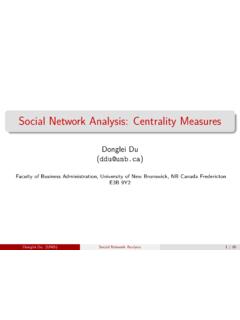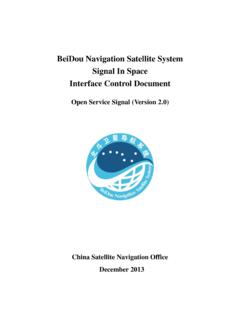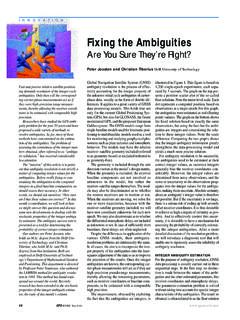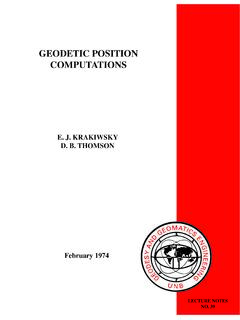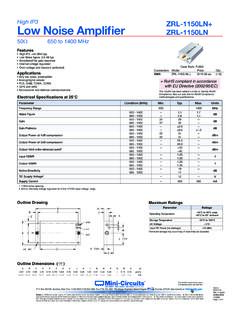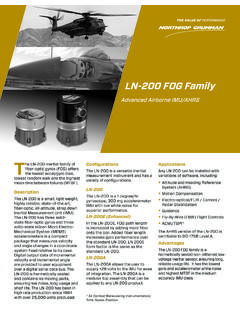Transcription of INTRODUCTION TO GEODETIC ASTRONOMY - UNB
1 INTRODUCTION TO GEODETIC ASTRONOMY D. B. THOMSOND ecember 1981 TECHNICAL REPORT NO. 217 LECTURE NOTES49 PREFACE In order to make our extensive series of lecture notes more readily available, we have scanned the old master copies and produced electronic versions in Portable Document Format. The quality of the images varies depending on the quality of the originals. Inthis version, images have been converted to searchable text. INTRODUCTION TO GEODETIC ASTRONOMY Donald B. Thomson Department of Geodesy and Geomatics Engineering University of New Brunswick Box 4400 Fredericton, Canada E3B SA3 September 1978 Reprinted with Corrections and Updates December 1981 Latest Reprinting January 1997 PREFACE These notes have been written for undergraduate students in Surveying Engineering at the University of New Brunswick. The overall objective is the development of a set of practical models for the determination of astronomic azimuth, latitude and longitude that utilize observations made to celestial objects.
2 It should be noted here that the emphasis in these notes is placed on the so-called second-order GEODETIC ASTRONOMY . This fact is reflected in the treatment of some of the subject matter. To facilitate the development of models, several major topics are covered, namely celestial coordinate systems and their relationships with terrestrial coordinate systems, variations in the celestial coordinates of a celestial body, time systems, timekeeping, and time dissemination. Finally, the reader should be aware of the fact that much of the information contained herein has been extracted from three primary references, namely Mueller [1969], Robbins [1976], and Krakiwsky and Wells [1971]. These, and several other's, are referenced extensively throughout these notes. Thomson. ii TABLE OF CONTENTS PREFACE LIST OF TABLES LIST OF FIGURES 1.
3 INTRODUCTION Basic Definitions 2. CELESTIAL COORDINAT~ SYSTEMS The Celestial Sphere Celestial Coordinate Systems Horizon System . Hour Angle System Right Ascension System. Ecliptic Sys tem Summary Page ii v vi 1 2 Transformations Amongst Celestial Coordinate Systems Horizon -Hour Angle 14 14 20 20 23 26 29 32 34 36 42 44 47 47 50 59 61 64 Hour Angle -Right Ascension Right Ascension -Ecliptic Summary Special Star Positions Rising and Setting of Stars Culmination (Transit) Prime Vertical Crossing. Elongation 3. TIME SYSTEMS Sidereal Time Universal (Solar) Time Standard(Zone) Time Relationships Between Sidereal and Solar Time Epochs and Intervals Irregularities of Rotational Time Systems Atomic Time System.
4 67 75 80 80 93 93 4. TIME DISSEMINATION, TIME-KEEPING, TIME RECORDING .. 95 Time Dissemination Time-Keeping and Recording. Time Observations 5. STAR CATALOGUES AND EPHEMERIDES Star Catalogues . Ephemerides and Almanacs iii .. 95 99 100 106 108 6. VARIATIONS IN CELESTIAL COORDINATES Precession, Nutation, and Proper Motion Annual Aberration and Parallax Diurnal Aberration, Geocentric Parallax, and Astronomic f'1.~(~~'~:.ton Polar Motion Page 117 118 127 134 138 7. DETERMINATION OF ASTRONOMIC AZIMUTH .. 147 Azimuth by Star Hour Angles Azimuth by Star Altitudes 8. DETERMINATION OF ASTRONOMIC LATITUDE Latitude by Meridian Zenith Distances Latitude by Polaris at any Hour Angle 9. DETERMINATION OF ASTRONOMIC LONGITUDE Longitude by Meridian Transit Times REFERENCES APPENDIX A Review of Spherical Trigonometry APPENDIX B Canadian Time Zones 148 154 163 164 165 170 172 175 176 183 APPENDIX C Excerpt from the Fourth Fundamental Catalogue (FK4).)
5 ,.. 184 APPENDIX D Excerpt from Apparent Places of Fundamental Stars 186 iv LIST OF TABLES Table 2-1 Celestial Coordinate Systems [Mueller, 1969] . 33 Table 2-2 Cartesian Celestial Coordinate Systems [Mueller, 1969] 33 Table 2-3 Transformations Among Celestial Coordinate Systems [Krakiwsky and Wells, 1978J . Table 6-1 Description of Terms . Table 7-1 Azimuth by Hour Angle:Random Errors in Latitude 600 [Robbins, 1976] Table 7-2 Azimuth by Altitude: Random Errors in Latitude 600 [Robbins, 1976] v 49 133 155 158 LIST OF FIGURES Figure 1-1 Biaxial Ellipsoid . 4 Figure 1-2 GEODETIC Latitude, Longitude, and Ellipsoidal Height 5 Figure 1-3 Orthometric Height Figure 1-4 Astronomic Latitude (~) and Longitude (A) 6 8 Figure 1-5 Geoid Height & Terrain Deflection of the Vertical.]
6 9 Figure 1-6 Components of the Deflection of the Vertical 10 Figure 1-7 GEODETIC Azimuth Figure 1-8 Astronomic Azimuth Figure 2-1 Cele,stial Sphere Figure 2-2 Astrono~ic Triangle.. Figure 2-3 Sun's Apparent Motion Figure 2-4 Horizon System .. Figure 2-5 Horizon System Figure 2-6 Hour Angle System. Figure 2-7 Hour Angle System Figure 2-8 Right Ascension System Figure 2-9 Right Ascension System Figure 2-10 Ecliptic System. Figure 2-11 Ecliptic System. Figure 2-12 Astronomic Triangle Figure 2-13 Local Sidereal Time .. vi .. 12 13 16 17 19 21 22 24 25 27 28 30 31 35 37 List of Figures Cont'd Figure 2-14 Figure 2-15 Horizon and Hour Angle System Transformations Horizon and Hour Angle Systems Figure 2-16 Hour Angle -Right Ascension Systems Figure 2-17 Right Ascension-Ecliptic Systems Figure 2-18 Celestial Coordinate System Relationships [Krakiwsky and , 1971].
7 Figure 2-19 Circumpolar and Equatorial Stars Figure 2-20 Declination for Visibility Figure 2-21 Rising and Setting of a Star Figure 2-22 Figure 2-23 Hour Angles of a Star's Rise and Set Rising and Setting of a Star Figure 2-24 Azimuths of a Star's Rise and Set. Figure 2-25 Culmination (Transit) Figure 2-26 Prime Vertical Crossing Figure 2-27 Elongation. Figure 3-1 Sidereal Time Epochs .. Figure 3-2 Equation of Equinoxes (OhUT, 1966) [Mueller, 1969] Figure 3-3 Figure 3-4 Figure 3-5 Figure 3,..6 Figure 3-7 Figure 3-8 Figure 3-9 Sidereal Time and Longitude Universal and Sideral Times fAA, 1981] Universal (Solar) Time . Equation of Time (OhUT, 1966) [Mueller, 1969] Solar Time and Longitude Standard (Zone) Time [Mueller, 1969] Relationships Between Sidereal and Universal Time Epochs vii 39 41 43 45 48 51 52 54 55 57 58 60 62 65 70 71 72 74 76 78 79 81 83 List of Figures Cont'd Figure 3-10 Sun -February.
8 1978 [SALS~ Figure 3-11 Mutual Conversion of Intervals of Solar and .Siderea1 Time [SALS, 19811 Figure 3-12a Universal and Sidereal Times, 1981 [AA,1981J Figure 3-12b Universal and Sidereal Times, 1981 cont'd. [AA, 1981] Figure 3-12c Universal and Sidereal Times, 1981 cont'd. Figure 4-1 Code for the Transmission of DUT1 86 87 88 89 90 97 Figure 4-2 ,: pating. of Events in the Vicinity of A Leap ~ 98 Figure 5-1 Universal and Sidereal Times, 1981 [AA 1981' ,. J 109 Figure 5-2 Bright Stars, [AA, r9S1] .. 110 .,-. Figure 5-3 Bright Stars, cont'd. [AA" 1281] .. III . / Figure 5-4 Sun -February, 1981 [SALS ,1981 L .. 113 Figure 5-5a Right Ascension of Stars, 1981 [BALS, 1981 ] . 114 Figure 5-5b Declination of Stars t 1981, [SALS, 1981]. 115 Figure 5-6 Pole Star Table, 1981 [SALS, 1-981].]]]]]
9 ' 116 Figure 6-1 Variations of the Right Ascension System 119 Figure 6-2 Motion of the Celestial Pole .. 121 Figure 6-3 Mean Celestial Coordinate Systems .. 123 Figure 6-4 True and Mean Celestial coordinate Systems 126 Figure 6-5 Aberration .. 0 0 . 0 0 0 0 0 0 0 . 129 Figure 6.;;.;6 Annual (Stellar) Parallax 0 . 0 0 0 0 130 Figure 6-7 Position Updating to 0 0 0 0 0 132 0 Figure 6-8 Geocentric Parallax .. 0 0 .. 0 0 0 0 0 136 viii List of Figures cont'd Figure 6-9 Figure 6-10 Astronomic Refraction . Observed to Apparent Place 137 139 Figure 6-11 Transformation of Apparent Place 141 Figure 6-12 Transformation from Instantaneous to Average Terrestrial Figure 6-13 Figure 6-:-14 Figure 7-1 Figure 7-1 Figure 7-2 System Celestial Coordinate Systems and Position Updating [Krakiwsky, Wells, 1971].
10 Coordinate Systems Used in Geodesy Azimuth by the Hour Angle of Polaris [Mueller, 1969] Cont'd Azimuth by the Sun's Altitude . ix 143 145 146 152 153 159 1. INTRODUCTION ASTRONOMY is defined as [Morris~ 19751 "The scientific study of the universe beyond the earth~ especially the observation, calculation, and theoretical interpretation of the positions, dimensions, distribution~ motion, composition, and evolution of celestial bodies and phenomena". ASTRONOMY is the oldest of the natural sciences dating back to ancient Chinese and Babylonian civilizations. Prior to 1609, when the telescope was invented, the naked eye was used for measurements. GEODETIC ASTRONOMY , on the other hand, is described as [Mueller, 1969] the art and science for determining, by astronomical observations, the positions of points on the earth and the azimuths of the GEODETIC lines connecting such points.]

